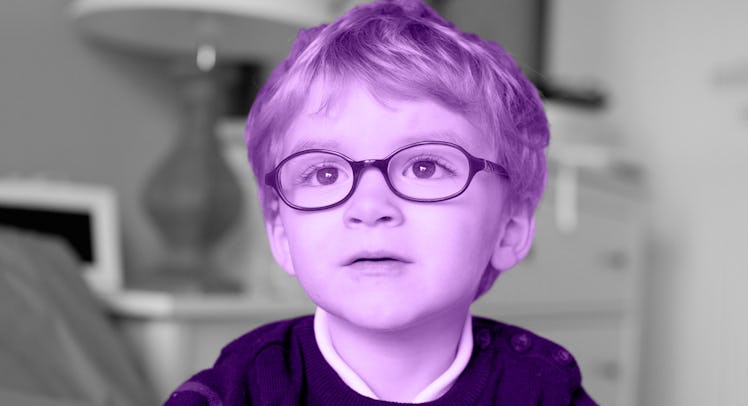How To Tell if a Young Kid Needs Glasses
Pediatricians might not always catch vision problems, parents should take the time to see an optometrist and keep vigilant for signs of eye troubles.

Once a child’s vision begins developing over its first month of life, they come to accept the way they see the world as normal. For this reason, issues with young kids’ eyesight are considerably harder to detect that oral or skin conditions. Though most children receive a preliminary eye exam from a pediatrician at about six months, which can flag potential developmental issues, optometrists suggest screenings at 1, 3, and 5 to help detect issues (the American Optometric Association offers free screening for babies between six and 12 months old). And they’ve got a point. Children with poor eyesight are often misdiagnosed with behavioral issues and prone to struggling in school. Glasses can make a massive difference.
The long and the short of it? Parents need to keep an eye out.
“If it looks like the child is struggling to see normally — if they stand extremely close to things, if they hold things close to them, if they squint a lot in bright light or don’t notice airplanes in the sky or do facial mimicry — that is a marker for possibly reduced vision,” says Dr. David Wheeler, a pediatric ophthalmologist with Tigard, Oregon’s Child Eye Care Associates.
Signs Your Kid Might Need Glasses
- Frequent squinting
- Frequent eye rubbing
- Chronic tilting of the head
- Child avoids or exhibits frustration when reading, coloring, or engaging in activities that require close focus
- Eyes are crossed
- Eyes turn in or out
- Failure to engage in facial mimicry and other mimicking behaviors
For most children, vision issues can be corrected simply by detecting deficiencies and getting the proper prescription glasses. However, issues like amblyopia — misleadingly known as lazy eye — can also be treated using an eye patch to strengthen the weaker eye. Other issues such as strabismus, which is characterized by crossed eyes, or eyes that rest in opposing directions, could require surgery if untreated.
Once symptoms are detected by parents, or even if something doesn’t feel quite right, parents should begin with an initial eye exam at the pediatrician.
RELATED: Why Your Kids Might Be Able to See Better if They Play Outdoors More Often
“Parents need to be not only observant but proactive when they’re in for their well-child visits,” says Wheeler. “They should make sure the pediatrician picks up the instrument called the ophthalmoscope. That simple task of picking up the ophthalmoscope and imaging the pupil in both eyes simultaneously is pretty efficient in detecting an abnormality and getting a kid to a specialist right away. Pediatricians are trained to do that, but they’re also responsible for many, many things and it can fall by the wayside.”
Sometimes figuring out whether a child is experiencing vision issues requires looking beyond overt physical symptoms. Occasionally, vision issues can result in frustration for a child, especially when they begin interacting with children who aren’t experiencing visual impairment.
“One thing that comes up is a kid who didn’t previously have behavioral issues gets into a classroom or a situation where they really need to focus on something up close… they start having behavioral issues, and that can be because they’re not seeing what they need to be seeing properly,” says Dr. Laura Armstrong of Portland, Oregon’s Alberta Eye Care.
ALSO: Warby Parker Unveils Line of Hipster Eyeglasses for Kids
As far as preventing future issues, both Wheeler and Armstrong say most impairments simply occur naturally and are not, contrary to popular opinion, the direct result of outside factors like video screens. That said, Armstrong recommends limiting screen time and ensuring children take frequent breaks from staring at the screen.
One factor that can affect eye health, however, is the sun. Armstrong says parents should be diligent in ensuring their children wear protective eyewear.
“If you put sunglasses on your face, you need to put sunglasses on your kid’s face too,” says Armstrong. “A lot of the things we see in adult eyes is sun exposure damage that they got as kids.”
MORE: 9 Child Vision Myths That Parents Should Start to See Past
The good news is that most eye afflictions can be treated with glasses, especially if they’re caught early. And because a child doesn’t know any better if their vision is blurred, it’s essential that parents remain vigilant and err on the side of caution rather than putting off what many misconstrue as a skippable visit to the optometrist.
“The things that worry me are the things that parents wouldn’t catch,” says Armstrong. “If we catch an issue when a kid is little, we can treat it so it doesn’t affect them for their whole life.”
This article was originally published on